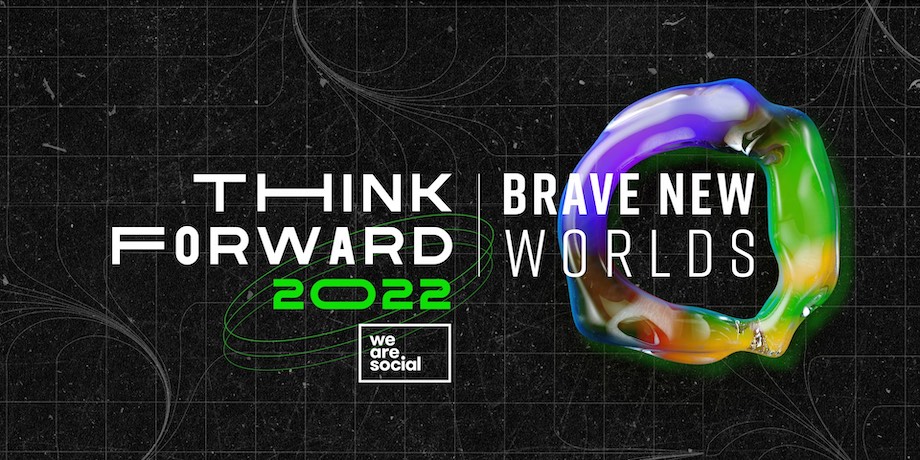We Are Social highlights social media learning, digital content trends and metaverse confusion in 2022 edition of Think Forward

Eight per cent of the world’s social media users have bought an NFT, while a third of Gen Zers who are on social platforms have spent money on digital clothing, global socially-led creative agency We Are Social reports in the new edition of Think Forward, its annual look at digital trends for the forthcoming year.
But while people who are on social media daily might be expected to be the most digitally literate, We Are Social’s research found that 87% of this group do not currently know what the metaverse is, while 85% are in the dark when it comes to understanding the concept of NFTs. In Australia, 83% of people declared that they don’t yet fully understand new internet concepts such as web3 and 35% would like to know more about cryptocurrencies.
Titled ‘Brave New Worlds’, the report unpicks the complex and ever-shifting web of digital culture and behaviour and explores the role brands can play in reflecting and shaping it. It is based on a series of trends identified by We Are Social’s Cultural Insights team, a network of 50 analysts and strategists globally, and supported by a survey of 3,000 people aged 18+ who use social media daily from the US, UK, France, Italy, China and Australia.
The Think Forward 2022 trends are:
In-Feed Syllabuses: Across the globe, social media users are more likely to say they’ve learned practical life skills from social platforms than university (57% vs 51%). Now, social media is being repurposed as a platform for self-directed learning, driven by immersive content formats and a renewed appreciation for innovative learning solutions. This creates opportunities for brands to impart knowledge to audiences from within their feeds.
The Vibe Economy: The rise of social video combined with a heightened desire for connection post-pandemic is seeing a new form of creativity move into the fore, defined by an ability to evoke specific emotional responses. Social has never been better equipped to do this, especially given that 30% of 18-34s say they use social with sound on more now than before Covid-19. For brands, it’s a great chance to inspire emotions in audiences – the ultimate goal of many long-term marketing strategies.
Prime-time Platforms: In a fragmented entertainment landscape, social has become the lynchpin of shared media consumption, with data from TikTok showing that 35% of its users say they’ve watched less TV and streaming services since downloading the app. Broadcasters can use this trend to their advantage by working with influencers and creators to come up with social-first formats. It’s also creating opportunities for brands to engage audiences more in online storytelling.
Social Cynicism: Social media has become a little predictable, with 43% of Gen Z users globally agreeing that the algorithms which determine what we see on our feeds have a negative impact on their media diet. In response, creators are pushing back with content poking fun at overdone tropes and worn-out memes, much to the delight of audiences. Brands need to do the same – novelty has never looked better.
New Materialists: From NFTs to designer Fortnite skins, a growing number of people are seeing the value of digital goods and putting hard cash behind them, including the 33% of Gen Zers who have invested in digital clothing. This is the new new money, and it’s redefining the status symbol for life online – the potential for brands to get involved is unlimited, but the rush to be in the first wave might not be the smart strategy.
Says Lore Oxford, global head of cultural insights at We Are Social: “Think Forward 2022’s predictions about the directions social content is headed highlight some really exciting trends for the creative minds in our industry. In particular, when it comes to curating a mood, it feels like the advent of a whole new artform, while the art of trope-busting is something our business excels at. We’re on the brink of a renaissance in creativity on social, in which brands and creators alike are going to have to work harder and better to make us laugh, move us, and connect us.”
Says Suzie Shaw, CEO at We Are Social Australia: “When looking at the local context, Australians have a good grasp of the current digital landscape and understand how algorithms impact their view of the world. But new concepts such as web3, cryptocurrencies and the metaverse feel less familiar. Regardless, they stimulate their curiosity and entice them to dip their toes, as 1 in 10 users have already bought digital clothes, and 16% of people would consider buying digital art. Brands need to understand what motivates these consumers and consider who to approach them, to ensure that if and when they will launch their first branded NFT, it will be effective in engaging the right audience.”
Read the full report here.
